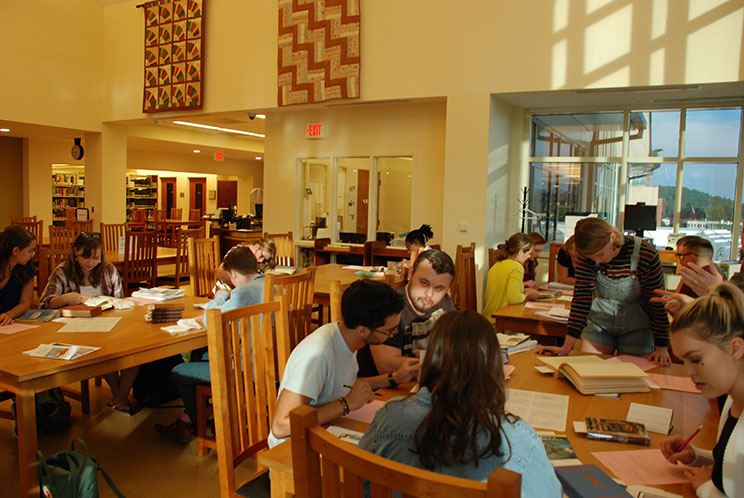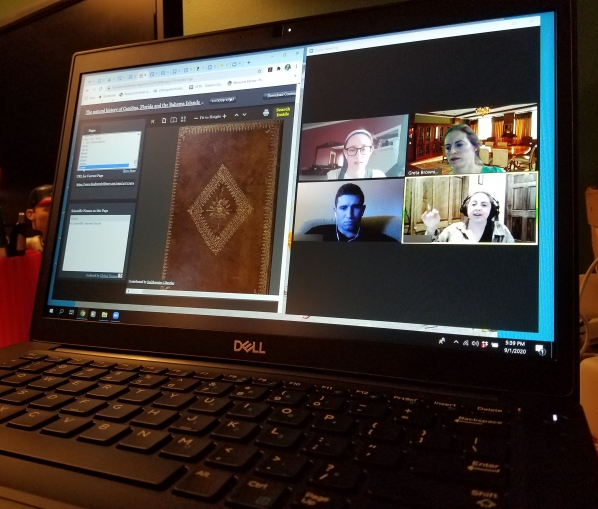This semester, I delivered remote instruction about Special Collections Research Center materials. Just how do you do that, when one of the most important features in teaching students about these items is to have a hands-on, experiential learning experience? As with most activities during the COVID-19 pandemic, the classes with which I worked caused me to rethink many of the approaches that I had used before.

Graduate students in ENG 5000 "Research and Bibliography" visit Special Collections in Fall 2018
I worked with only four classes this Fall semester, significantly fewer classes than the 25 or so classes I normally see. Some instructors decided to provide instruction about our resources on their own and did not schedule instruction sessions, others eliminated assignments using Special Collections material for a variety of reasons, including our limited open hours at the beginning of the semester, fears that the University would move all classes online (they never did), or they could not devote as much time to these assignments or instruction sessions because other parts of the curriculum were taking longer to deliver in either hybrid or online formats. As a result, my colleagues and I answered many more email questions from students related to their specific assignments than usual.

Graduate students in ENG 5000 "Research and Bibliography" engage in a Zoom breakout room during their Special Collections session in Fall 2020
The instruction that I did deliver, however, was reimagined to different degrees. In one class, ENG 5000 “English and Bibliography,” I had to completely transform the content that I normally delivered in person to a virtual environment. The purpose of this class visit to Special Collections was to introduce graduate students to our collections and rare materials that they could incorporate into their research projects during their graduate work. I flipped the classroom and provided advance video watching “homework,” including a slide lecture on the history of the book that I recorded for the class, and used digital surrogates from other libraries, rather than physical books, for a rare book analysis small group exercise. During the class, we reviewed relevant terms from the history of the book lecture and then jumped into the small group exercise using Zoom breakout rooms. After the exercise, we held a discussion in the main room. This approach called for a lot of preparation more than normal, but the professor and the students seemed to enjoy it.
In another class, HIS 3575 “Public History: Introduction to the Field,” I joined a hybrid class in which some students were physically in the classroom with the instructor and others were on Zoom with me. In this class, the students were learning about local sources that they could use on historically-based digital posters at the end of the semester. My preparation for this class was more like normal: I updated my “Appalachian History” LibGuide with additional e-resources and databases and practiced sample searches to demonstrate different search tools. One aspect of this class that I discovered during the session was that when I was sharing my screen to demonstrate searching, I could not see the faces of the students to know if they were following along or not. Normally, a quick glance at the room helps you gauge whether or not they are “getting it.” So, when I finished demonstrating one tool, I deliberately stopped sharing my screen and asked if there were any questions. They “seemed” to be following along. I hope!
In UCO 1200, Section 131, “Pictures and Stories: Our Place,” I needed to redesign my former, in-person approach. This class visits us each semester to use resources on local topics for end-of-semester projects. In February 2020, before the pandemic and associated teleworking was in full force, I taught this class for the second time, and I felt like I had just figured out how to teach it to the satisfaction of the instructor and the students. It relied on the public services staff (a colleague and myself) pulling relevant items from our circulating and archival collections for groups to research during their class period. In the virtual world, of course, this approach was impossible. Knowing that I had to do a little more legwork for this class, I obtained the groups’ topics from the instructor in advance (in this case, a tight two days), and searched for each one in our collection databases. What I presented to the class was a demonstration of how to use a selection of our databases (catalog, finding aids search, etc. on our Search Tools page) using their topics. I provided a link in the chat box of “top hit” resources for each group so that they would each have something to start with in their research. I learned that using the chat box was helpful to the students in the HIS 3575 class when the instructor used it to convey possible search terms to the students as I talked about them.
To say that this semester has been a learning experience for teaching online with special collections materials is a bit of an understatement. It is definitely something that I, as a special collections instructor, never would have considered previously. In each of the instances described, my success would not have been possible without the strong support of the instructors who assisted me in preparation and delivery of my content. These partnerships in the virtual classroom are more important now than they were when we met physically. Additionally, I would not have been able to proceed so successfully without the support of my library colleagues who teach virtually more regularly than I, as well as the professional archival and special collections community (Teaching with Primary Sources Collective) who have shared ideas and experiences through regular Zoom community calls since the spring. It looks like we will be continuing virtual instruction for a while, and I look forward to working with more classes in new ways!
By Greta Browning, Reference Archivist/Librarian and Curator of the Rhinehart Rare Book Collection

